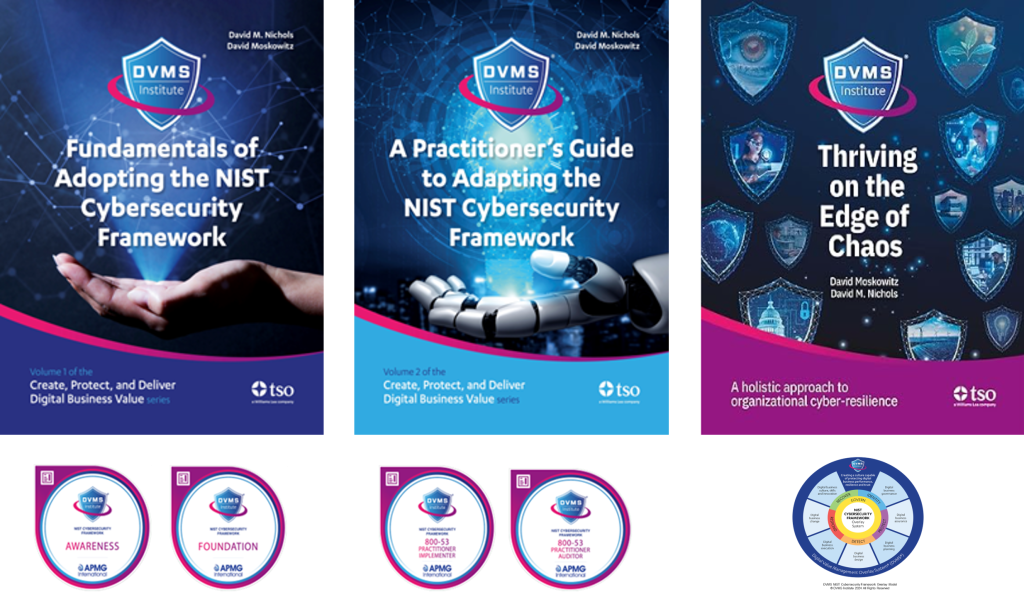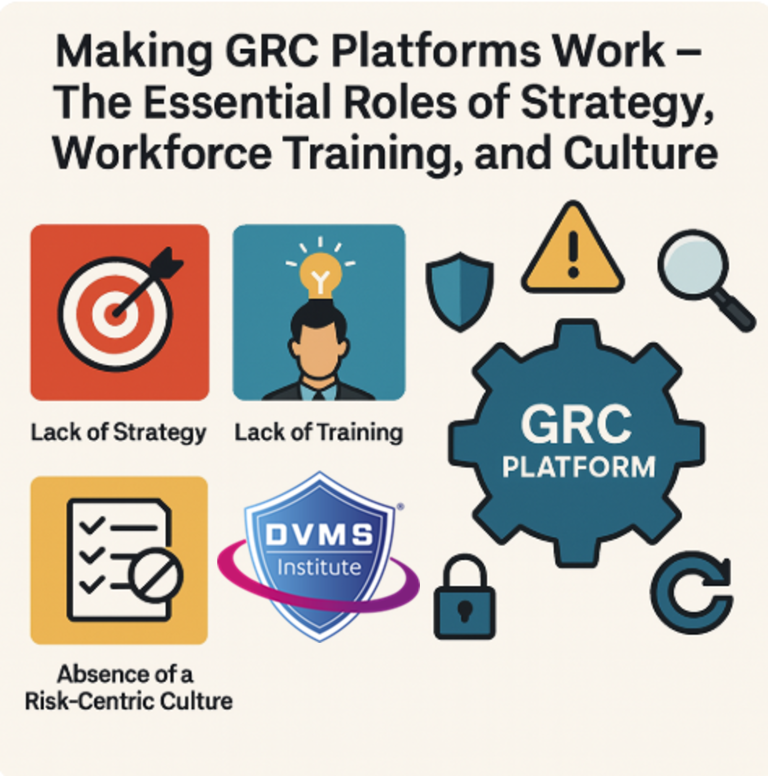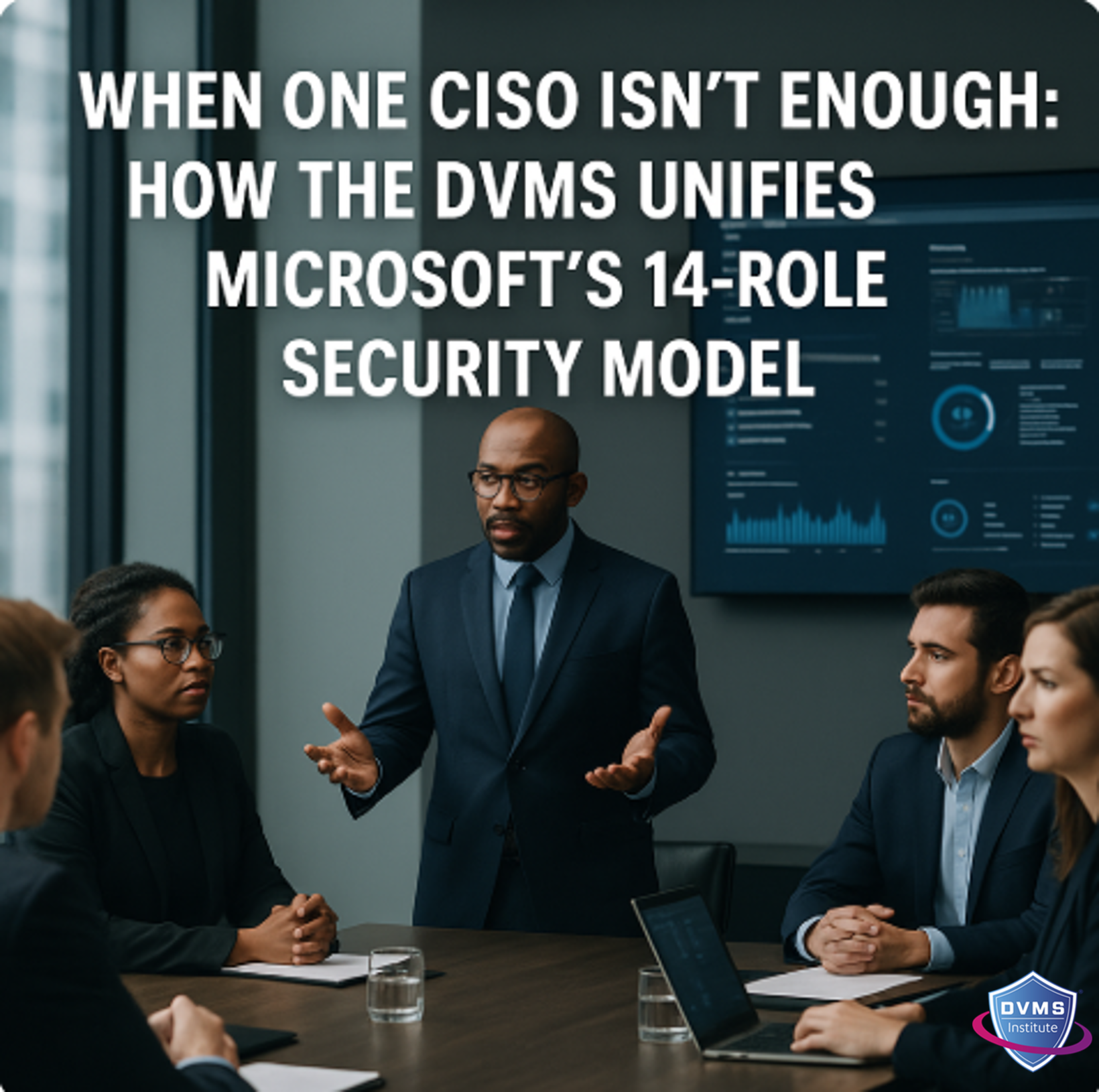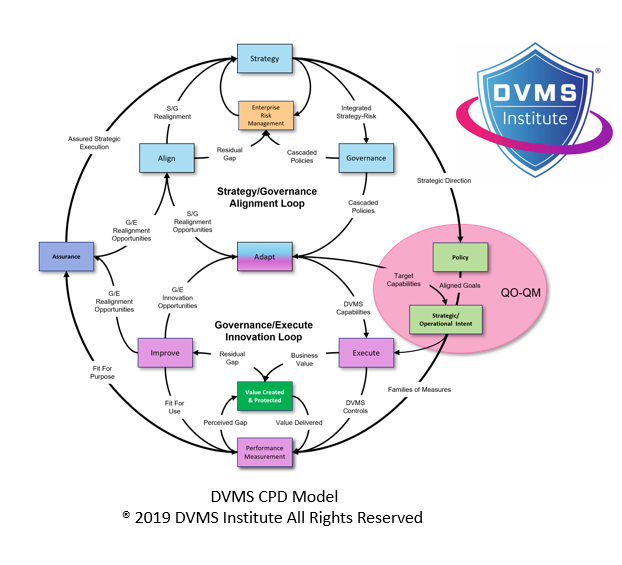Making GRC Platforms Work – The Essential Roles of Strategy, Workforce Training, and Culture
Rick Lemieux – Co-Founder and Chief Product Officer of the DVMS Institute
Introduction: The Illusion of Safety Through Technology
Organizations often invest in Governance, Risk, and Compliance (GRC) platforms, believing they are acquiring a turnkey cybersecurity and digital risk management solution. However, failure is nearly inevitable when these platforms are deployed without a well-defined strategy, a trained workforce, and a culture committed to proactively identifying and mitigating systemic risks. Technology, in isolation, cannot substitute for strategic alignment, human capability, and cultural maturity. As the NIST Cybersecurity Framework (CSF) 2.0 and the Digital Value Management System (DVMS) make apparent, success in managing digital business risk depends on viewing cybersecurity not as an IT function but as an enterprise-wide responsibility woven into governance and culture.
Lack of Strategy: Misaligned Tools, Misguided Outcomes
A GRC platform is only as effective as the strategy guiding its implementation and use. The NIST CSF emphasizes that cybersecurity outcomes must be tied to organizational missions and stakeholder expectations through the “GOVERN” function, establishing strategy, roles, policy, and oversight. Organizations often implement GRC tools without such strategic clarity as standalone initiatives, disconnected from enterprise risk management (ERM) objectives.
The DVMS Institute underscores this problem by introducing the concept of “strategy-risk”—a unified view that treats strategy and risk as inseparable. GRC tools lacking this unified view become compliance checklists rather than dynamic risk management instruments. They may generate reports and dashboards, but without strategic context, these outputs offer little actionable insight. Consequently, organizations are left with data, but no direction.
Lack of Training: Unprepared People, Underutilized Tools
Technology cannot overcome a lack of human capability. Without a trained workforce, GRC platforms are underutilized, misconfigured, or misunderstood. NIST CSF 2.0 promotes awareness and training as essential protective outcomes under the “PROTECT” function, highlighting that training is fundamental to managing risk, not ancillary.
The DVMS approach builds on this by promoting learning organizations that continuously adapt through upskilling and cross-functional collaboration. The 3D Knowledge Model, for example, addresses how teams learn and align their behaviors across past, present, and future needs—something no GRC dashboard can do independently. Inadequate training leads to misinterpretation of platform data, failure to integrate insights into operations, and ultimately, risk blind spots.
Absence of a Risk-Centric Culture: Compliance Over Resilience
When not embedded in a proactive risk culture, GRC platforms often encourage a “checkbox” mentality. They can foster the illusion of control through automated audits and risk registers, even as deeper systemic vulnerabilities go unnoticed. As highlighted in NIST CSF 2.0, cybersecurity governance must reflect a comprehensive understanding of the organizational context, supply chains, and stakeholder expectations.
The DVMS emphasizes that culture—the collective values and assumptions of the organization—shapes how risk is perceived and addressed. The DVMS views culture as a key strategic asset or liability. A culture that fails to reward questioning or transparency will ignore indicators surfaced by the GRC platform. Without cultural integration, GRC adoption is superficial, lacking the engagement needed to manage digital value holistically.
Systemic Risk Blindness: Failure to See the Whole
One of the most critical failures of GRC platforms without strategic integration is the inability to address systemic risk. NIST CSF’s Core Functions (GOVERN, IDENTIFY, PROTECT, DETECT, RESPOND, RECOVER) provide continuous, integrated risk management. Using the CSF as a wheel—with GOVERN at the center—illustrates that governance must inform and unify all other activities.
Yet GRC platforms, when siloed, often reinforce fragmented thinking. The DVMS challenges organizations to see themselves as complex adaptive systems, where changes in one part (e.g., policy) ripple across others (e.g., operations, reputation). Tools must be leveraged within this context to surface, prioritize, and mitigate systemic risks, not just tactical gaps.
From Platforms to Performance: Building Organizational Resilience
The promise of GRC tools lies not in automation, but in their potential to enhance decision-making across the enterprise. This requires more than data integration—it demands strategic coherence, workforce readiness, and cultural evolution. The DVMS introduces concepts like the CPD Model (Create, Protect, Deliver) and the Z-X Model (seven minimum viable capabilities) to ensure platforms serve business outcomes, not merely technical outputs.
Real success comes from a risk-informed culture where GRC insights influence strategic planning, where all teams—from finance to facilities—see themselves as stewards of digital value, and where leadership takes accountability for embedding risk thinking into decision-making at every level.
Conclusion: Technology Is Not a Substitute for Thinking
GRC platforms can accelerate and scale risk management—but only if embedded within a strategy that links risk to value, executed by a trained and engaged workforce, and reinforced by a culture of vigilance, questioning, and continuous learning. As echoed in both NIST CSF 2.0 and the DVMS body of knowledge, resilience is not the result of tools but of thinking differently.
Organizations that rely on GRC technology without these human and strategic foundations are setting themselves up for underperformance and catastrophic failure when the inevitable breach arrives. The technology is not broken—the context is. Organizations must change how they see, think, and act on risk to fix it.
About the Author

Rick Lemieux
Co-Founder and Chief Product Officer of the DVMS Institute
Rick has 40+ years of passion and experience creating solutions to give organizations a competitive edge in their service markets. In 2015, Rick was identified as one of the top five IT Entrepreneurs in the State of Rhode Island by the TECH 10 awards for developing innovative training and mentoring solutions for boards, senior executives, and operational stakeholders.
In today’s digitally driven economy, cyber disruptions are no longer an “if” but a “when.”
The DVMS Institute’s Certified Training Programs teach organizations the skills to build a Holistic and Culture-Aligned Overlay System capable of coordinating Adaptive, Governance, Resilience, and Assurance actions across a Complex Digital Ecosystem.
Achieving true cyber resilience across a complex digital ecosystem requires seamless alignment between organizational Strategy, Governance, and Operations, underpinned by a culture dedicated to sustaining and continuously innovating organizational digital value.

The DVMS positions cyber resilience as a strategic, enterprise-wide capability powered by the Institute’s CPD, Z-X, and 3D Knowledge models.
This systems-based approach to cyber operational resilience demands active engagement from all members of the Digital Ecosystem, with each member playing a distinct role in proactively identifying and mitigating the systemic risks that threaten digital business operations.
This adaptive, forward-looking approach to Governance, Resilience, and Assurance (GRA) positions businesses to:
- Maintain Operational Stability Amidst Constant Digital Disruption
- Drive Agility and Trust Across Your Digital Ecosystem
- Satisfy Critical Regulatory and Certification Requirements
- Leverage Cyber Resilience as a Competitive Advantage
DVMS Explainer Videos
- Architecture Video: David Moskowitz explains the DVMS System
- Case Study Video: Dr. Joseph Baugh Shares His DVMS Story.
- Overlay Model – What is an Overlay Model
- ZX Model – The MVC’s that power operational resilience
- CPD Model – Adaptable governance and assurance
- 3D Knowledge Model – Enabling holistic organizational learning
- FastTrack Model – A phased approach to cyber resilience
Digital Value Management System® is a registered trademark of the DVMS Institute LLC.
® DVMS Institute 2025 All Rights Reserved




